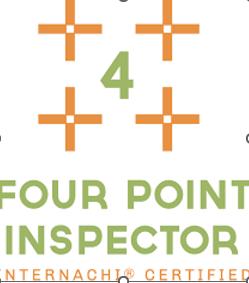What is a 4-Point Inspection?

What is a 4-Point Inspection?
A 4-Point Inspection is likely
something you're already familiar with if you own or just bought an older house
(To acquire insurance coverage for the property, you probably had to have a
home inspection). An inspection may be necessary for a house that has been on
the market for more than 30 years (or fewer if it's an investment property).
It's all for the insurance company's good, telling them how much risk they're
incurring by insuring your home. During Hurricane Andrew's passage in 1992, the
idea of a 4-Point examination was first proposed. An unexpected amount of money
was lost due to this storm, which surprised the insurance industry. It was
assumed that the construction materials had a longer lifetime and would
withstand passing storms more effectively. Because of this startling discovery,
the industry is now looking for methods to evaluate the competence of the
materials used in the houses it insures.
So,
What Exactly Is a 4-Point Checklist?
Focuses on the four most important
factors from an insurance risk perspective. The following are included in the
package:
1. Roof
2. Electrical System
3. Heating and Cooling Systems
4. Plumbing Systems
You may be denied
coverage if your systems are outdated or judged more prone to breakdown. The
most often reported things in insurance claims fall under these four
categories. For this 4 Point examination, the
inspector is looking for evidence of how well these four important components
work, how old they are, and any faults that could impair their performance.
The Roof
To qualify for coverage, a new roof
must be installed on any asphalt shingle roof that is 19 years old or older.
However, the exact conditions vary from insurer to insurer. Tile (concrete or
clay) roofs that are much more than 40 years old are in the same boat as newer
ones. If the roof you now have is damaged or is leaking, you may expect to be
asked to fix or replace the roof before you can get insurance coverage. A
problem may come up during the inspection if you have significant granule loss,
lifted shingles, cracked and missing tiles, or damaged or missing fasteners on
your roof.
The inspector will document the
roof's materials. He or she will take pictures and make notes on the roof's
current state. They'll look into the roof's history and see whether any permits
were issued for its construction.
The Electrical System
A fuse breaker box built by
specific companies that have been judged dangerous may have to be replaced
(like Federal Pacific, Zinsco, Challenger, and Sylvania). Because of these
boxes' high fire danger, it's in your best interest to get rid of them.
You can anticipate having to
replace any components that include screw-in fuses or wiring with knobs and
tubes. Aluminum wire and cloth-lined wiring are the same. No double-tapped
breakers, two-prong outlets, or neutrals/grounds should be on the same bus bar
in subpanels. Budget for installing GFCI or AFCI protection in your house if
you don't already have it.
The inspector will record the kind
of wiring to complete this examination section (copper, aluminum, cloth-covered
wire, etc.). Nearly nine out of ten house fires are the result of improper
wiring. Therefore the inspector will check for that.
Heating and Cooling System
There will be issues if you don't
have central heating and cooling in your house. An air-conditioning system will
be documented if the home has one, so long as it's working and in good working
order. They'll keep a record of the state of the machinery. Is there any
obvious evidence of failure or neglect?
The Plumbing System
It is now known that some materials
were not as good for the work as initially anticipated because of changes in
the plumbing materials through time. Polybutylene and Orangeburg pipe were
widely utilized, but they have a history of failure. Because of this,
anticipate the insurance provider to demand that these systems be replaced
before issuing coverage. A water heater older than 18 years old may have an
impact on your insurance coverage. Water heaters were much safer during this
time because of new safety measures. The revised component designs prevented
ignition from leaking. Therefore the devices no longer needed to be raised 18
inches from the floor after 2003.
Having most of these systems
doesn't always indicate that you'll be without insurance. You may need to
forego certain coverages to get the insurance. In the case of a failure, the
insurance company will not reimburse the cost of that deleted component.
During the inspection, the
inspector will note the materials used to create the pipe. These professionals
will inspect the water heater and pipe system for any leaks or other problems.
When they inspect the water heater, they'll see that it has a
temperature-pressure relief (TPR) valve and a correctly installed discharge
tube.
As a
result, who is qualified to conduct 4-Point inspections?
Any of the following (and the
necessary training to pass these exams) qualify as candidates for conducting
4-Point inspections:
1.
A general contractor, whether it is for a home or a
structure,
2.
An official tasked with enforcing construction codes.
3.
Architects who are licensed
4.
A house inspection is carried out by a professional.
5.
A qualified and experienced engineer
6.
A Florida-licensed construction official tasked with
verifying that structures meet state building codes
As a reminder,
qualified tradespeople may sign off on their parts of the 4-point inspection
process (i.e., A roofer can sign off on the roofing portion).
Closing

Comments